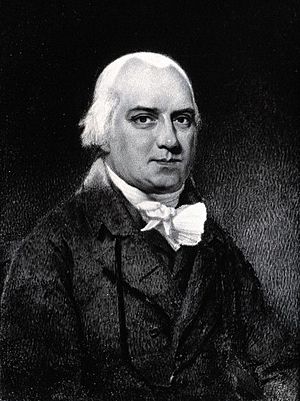Robert Willan facts for kids
Quick facts for kids
Robert Willian
|
|
|---|---|

Photograph of Robert Willan
|
|
| Born | 12 November 1757 |
| Died | 7 April 1812 Madeira
|
| Occupation | Dermatologist |
Robert Willan FRS was an important English doctor. He lived from 1757 to 1812. He is known as the founder of dermatology. Dermatology is the medical field that studies skin diseases.
Life of Robert Willan
Robert Willan was born on November 12, 1757. His birthplace was near Sedbergh, in Yorkshire, England. He went to Sedbergh School for his education. Later, he studied medicine at the University of Edinburgh. He earned his medical degree in 1780.
In 1781, he started working as a doctor in Darlington. Two years later, in 1783, he moved to London. There, he became a physician at the new Carey Street Public Dispensary. He worked there until 1803. During this time, he also taught alongside another doctor, Thomas Bateman. In 1809, he was chosen to be a Fellow of the Royal Society. Robert Willan passed away on April 7, 1812, in Madeira.
Willan's Important Work
Robert Willan was a pioneer in studying skin diseases. He tried to organize and classify them. He used a system similar to the one Carl Linnaeus used for plants and animals. Willan described many different skin conditions. These included impetigo, lupus, psoriasis, and ichthyosis. He also described scleroderma, sycosis, and pemphigus.
Willan and Thomas Bateman worked together. They made the first attempt to classify skin diseases based on where they appeared on the body. For many years, Willan's picture was on the cover of the British Journal of Dermatology.
In 1790, Willan received a special award. It was the Fothergill Gold Medal. He got it for his work on classifying skin diseases. That same year, he wrote about a unique medical case. It was called "A Remarkable Case of Abstinence." This account described a young man who fasted for 78 days.
One of his books was translated into German. It was published in 1799 in Breslau. The original English version of that work is now lost.
In 1798, Willan described a skin condition called psoriasis diffusa. This was an occupational disease. It mainly affected the hands and arms of bakers. A year later, in 1799, he was the first to describe a common childhood rash. It is known as erythema infectiosum.
Willan's important book, On Cutaneous Diseases, came out in 1808. In this book, he used the word "lupus" for the first time. He used it to describe a type of skin tuberculosis.
See also

